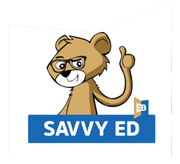With its combination of ambitious approach and unique content, Savvy Ed appeals to children, parents and teachers alike!
THE TICKET – A STORY
Long texts are most effective as they facilitate brain exposure to phrases and structures used in a variety of contexts. The longer the text, the more examples, and the more examples – the higher the chance that the learner’s brain will start establishing rules. Our coursebook has been designed around this principle. At first, learners try to understand a story in a listening comprehension activity, then they learn to read it, and finally also to recount the story using their own words. To make this possible, the story must be recorded and illustrated in a funny and interesting way, and the teacher must have over a dozen ideas how to use it in class. And this is exactly the case! Not only with this particular story, but with all the stories included in the coursebook!
The Ticket - part 1
The Ticket - part 2
I AM SAVVY – A GRAMMAR RHYME
Rhythm, sound and movement facilitate remembering, which is why we discard widely disliked rote memorisation of grammar rules in favour of rhymes which effectively introduce learners to the patterns of English grammar. Because rather than mindlessly conjugate the verb TO BE, it is much easier to… start RAPPING and get the verb forms stuck in our young learners’ heads effortlessly! When combined with games featuring friendly competition and a system of rewards, this method is bound for success.
I am Savvy
THE GOLD KINGDOM – A MOTIVATION SCHEME
Young learners often need a physical token of recognition, a small reward which keeps them assured that they are making progress. In the first year, Savvy Ed takes children on an adventure to the Gold Kingdom. Learners are given nuggets of gold as their reward for completing tasks and using English in class. This motivation “carrot” soon gives rise to intrinsic motivation, which according to experts is the only type of motivation promoting success. Gold nuggets can be exchanged for stickers which are used to construct a kingdom in each student’s coursebook. As young learners accumulate knowledge, they
expand their empire, which gives them pride and satisfaction.
OUR MOTIVATION SCHEME (8MB)
PUZZLES - A SYSTEMIC TASK
Our Savvy Ed method is based on systemic tasks. They involve repetitive practice of a given skill (such as level 1 reading) in the form of short, standardised activities included in each class, which mostly use special, ready- to-use activity cards. Children are eager to read and solve puzzles because they are interesting and contain an element of surprise. In the course of the school year, the puzzles become longer and more challenging, which facilitates gradual development of students’ skills and abilities. Obviously, our puzzles would not be such fun if it weren’t for the fisherman game and a few other games known and used by all our teachers.
Systemic tasks
SNOWBALL BOOK – WORKBOOK
Our method uses the snowball effect, which means that the language content gradually grows and expands, just like a snowball rolling down a snow-covered slope. Skills and vocabulary already mastered by our learners are enhanced with the addition of new content, which helps consolidate and refresh their knowledge. Sounds complicated? Not to us! Our workbook is constructed in a way that helps recycle vocabulary and grammar structures, which repeatedly come back to learners in new contexts, just like a boomerang (actually, the very symbol of a boomerang is used to mark all revision activities). This way, each element introduced in the course is revisited, which greatly facilitates the teaching process. According to studies, only systematic revision brings sustainable effects!
